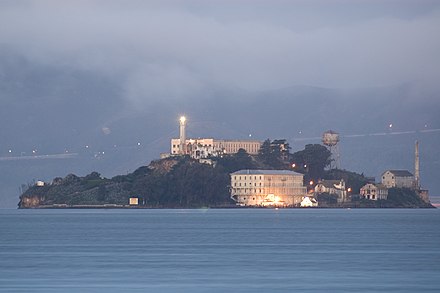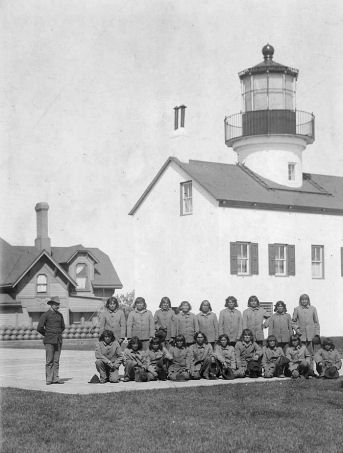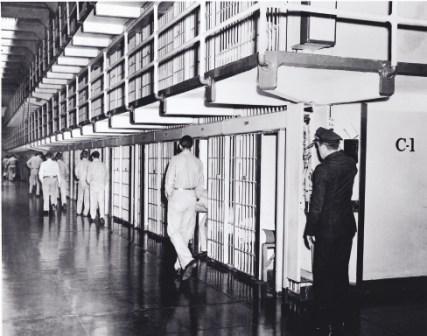
Robert Franklin Stroud, known as the "Birdman of Alcatraz", was a convicted murderer, American federal prisoner and author who has been cited as one of the most notorious criminals in the United States. During his time at Leavenworth Penitentiary, he reared and sold birds and became a respected ornithologist, although regulations did not allow him to keep birds at Alcatraz, where he was incarcerated from 1942 to 1959. Stroud was never released from the federal prison system; he was imprisoned from 1909 to his death in 1963.

The Eastern State Penitentiary, also known as ESP, is a former American prison in Philadelphia, Pennsylvania. It is located at 2027 Fairmount Avenue between Corinthian Avenue and North 22nd Street in the Fairmount section of the city, and was operational from 1829 until 1971. The penitentiary refined the revolutionary system of separate incarceration first pioneered at the Walnut Street Jail which emphasized principles of reform rather than punishment.

Yūrei (幽霊) are figures in Japanese folklore analogous to the Western model of ghosts. The name consists of two kanji, 幽 (yū), meaning "faint" or "dim" and 霊 (rei), meaning "soul" or "spirit". Alternative names include 亡霊, meaning ruined or departed spirit, 死霊 meaning dead spirit, or the more encompassing 妖怪 or お化け. Like their Chinese and Western counterparts, they are thought to be spirits barred from a peaceful afterlife.

The Ohio State Reformatory (OSR), also known as the Mansfield Reformatory, is a historic prison located in Mansfield, Ohio in the United States. It was built between 1886 and 1910 and remained in operation until 1990, when a United States Federal Court ruling ordered the facility to be closed. While this facility was used in a number of films, TV shows and music videos, it was made famous by the film The Shawshank Redemption (1994) when it was used for the majority of the movie.

The Penitentiary of New Mexico (PNM) is a men's maximum-security prison located in unincorporated Santa Fe County, 15 miles (24 km) south of central Santa Fe, on New Mexico State Road 14. It is operated by the New Mexico Corrections Department.

Henri Theodore Young was a convicted bank robber and murderer who, while serving one of a series of prison terms, attempted a 1939 escape from Alcatraz Federal Penitentiary with four other inmates. During the escape attempt two inmates were shot, and one died of his wounds. All surviving were quickly recaptured. Two, Young and Rufus McCain, received sentences of solitary confinement and served them at Alcatraz for a period of three years. 11 days after re-entering the Alcatraz general prison population, Young murdered fellow escapee McCain. No apparent motive was ever disclosed. Young's defense put Alcatraz and the penal system on trial, leading to questions about how the prison was run. In 1948, Young was transferred from Alcatraz to the Medical Center for Federal Prisoners, Springfield, Missouri. He was later transferred to Washington State Penitentiary at Walla Walla upon completion of his federal sentence to begin a life sentence for the 1933 murder conviction.

The June 1962 Alcatraz escape was a prison break from Alcatraz Federal Penitentiary, a maximum-security facility located on an island in San Francisco Bay, undertaken by inmates Frank Morris and brothers John and Clarence Anglin. The three men were able to escape from their cells and leave the island in a makeshift raft.
The following are reportedly haunted locations in California, in the United States. This list is sorted by county.
The following are reportedly haunted locations in Pennsylvania:

Alcatraz Dining Hall, often referred to as the Mess Hall, is the dining hall of Alcatraz Federal Penitentiary where the prisoners and staff ate their meals. It is a long wing on the west end of the Main Cellhouse of Alcatraz, situated in the center of the island. It is connected to the block by a corridor known as “Times Square”, as it passes beneath a large clock approaching the entrance way to the dining hall. This wing includes the dining hall and the kitchen beyond it.

The New Industries Building is a building on the western end of Alcatraz Island off the coast of San Francisco, USA. It was constructed in 1939 for $186,000 as part of a $1.1 million modernization scheme which also included the water tower, power house, officers quarters and remodeling of the D-block.

The Alcatraz Federal Penitentiary or United States Penitentiary, Alcatraz Island was a maximum security federal prison on Alcatraz Island, 1.25 miles (2.01 km) off the coast of San Francisco, California, United States, the site of a fort since the 1850s; the main prison building was built in 1910–1912 as a United States Army military prison. The United States Department of Justice acquired the United States Disciplinary Barracks, Pacific Branch, on Alcatraz on 12 October 1933, and the island became a prison of the Federal Bureau of Prisons in August 1934 after the buildings were modernized and security increased. Given this high security and the island's location in the cold waters and strong currents of San Francisco Bay, prison operators believed Alcatraz to be escape-proof and America's strongest prison.

Alcatraz Hospital is a defunct hospital which was located on Alcatraz Island, California, US. It began operations in the 19th century while the United States Army operated Fort Alcatraz and continued to provide services after the transition to the Alcatraz Federal Penitentiary. Though Alcatraz is now part of the Golden Gate National Recreation Area, the hospital is not included on the general tour.
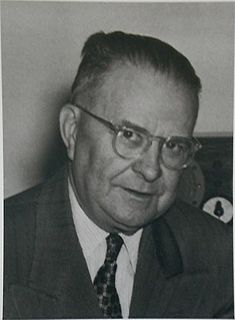
Edwin Burnham Swope, nicknamed "Cowboy", was the second warden of Alcatraz Federal Penitentiary, which was situated on Alcatraz Island, California, US. He was a native of New Mexico, having been born at Santa Fe in 1888. His earlier posts as warden included New Mexico State Prison, Washington State's McNeil Island Federal Penitentiary, and the Federal Penitentiary at Terre Haute, Indiana. Swope served at Alcatraz from 1948 to 1955. A member of the Democratic Party, Swope was Chairman of the City Commission of Albuquerque, New Mexico from February 1923 through February 1925. He was appointed Commissioner of Public Lands by New Mexico Governor Arthur T. Hannett.

Olin Guy Blackwell was an American lawman who was the fourth and final warden of Alcatraz Federal Penitentiary, which was situated on Alcatraz Island, California. Associate Warden to Paul J. Madigan from April 1959, Blackwell served as warden of Alcatraz at its most difficult time from 1961 to 1963 when it was facing closure as a decaying prison and financing problems and at the time of the June 1962 escape. At that time, he was on vacation in Lake Berryessa in Napa County, California, and he didn't believe the men could have survived the waters and make it to shore. The prison closed on March 21, 1963. Blackwell was considered to have been the least strict warden of Alcatraz, perhaps in part due to him having been a heavy drinker and smoker, nicknamed "Gypsy" and known as "Blackie" to his friends. He was said to have been an excellent marksman; who had earlier served as Associate Warden of Lewisburg Federal Penitentiary. He died on March 7, 1986 in Hart County Georgia.

Rufe Persful was an American criminal, convicted for murder, kidnapping and robbery. He was considered one of the most dangerous criminals of his era by the authorities. Convicted with the murder and robbery of an elderly man at the age of 18, he was sentenced to 15 years in Arkansas State Penitentiary, but unlike a standard prison, it involved farm labour. He was given the task of shooting fellow inmates with a shotgun if they attempted to escape. He killed and disabled many prisoners during his time at the Arkansas Penitentiary, punctuated by periods of parole as a reward for his prison protection, and then re-offending and being sent back to resume his role. In December 1934, Persful was convicted for kidnapping and robbery in Paragould, Arkansas and sentenced to 20 years, after which he was transferred to United States Penitentiary, Atlanta. Two inmates recognized him from Arkansas and word spread of his killing of fellow inmates and he began being severely abused. He was transferred to Alcatraz Federal Penitentiary a year later but was recognized and continued to be tortured by his fellow inmates because of his past offenses. In 1937, it was Persful who attempted to cut off his hands in sheer desperation of his experiences at Alcatraz and was diagnosed with schizophrenia. He was eventually sent to McNeil Island Penitentiary where he was again recognized and suffered much abuse from his fellow inmates, despite being heavily watched over by the prison staff. He was released in April 1948 and moved in with a relative in Gary, Indiana, never to be convicted of a crime again.
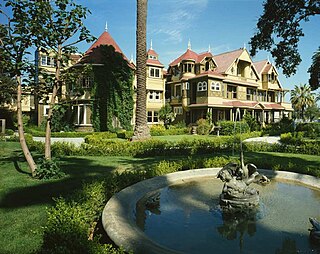
There are many reportedly haunted locations in San Francisco, California. According to ghost hunters, over 100 sites in the San Francisco Bay Area are reported to be haunted.

There are a number of widely reported haunted locations in the state of Oregon in the United States. Many reported hauntings in Oregon are linked to such historic places as the Oregon Trail and early coastal communities. Portland, the state's largest city and metropolitan area, was considered one of the most dangerous port cities in the world at the turn of the 20th century. Its gritty history includes many locations alleged or reported to be haunted. In 2012, USA Today named Portland among the top ten most haunted cities in the United States.

